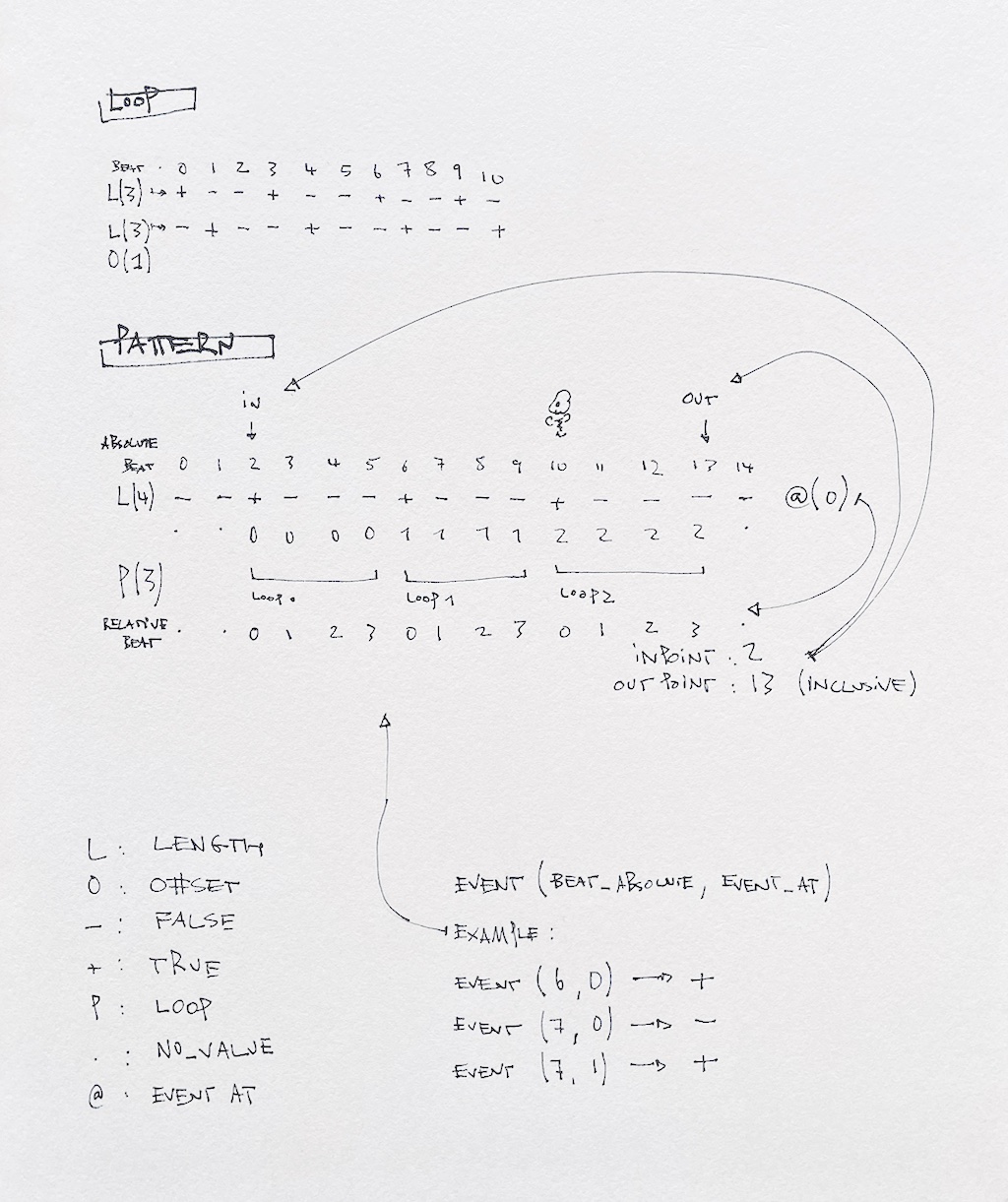Compositional Techniques: Patterns

the past days i have been looking into techniques for ( algorithmic ) compositions.
there is SOOOOooo… much stuff123 out there already. but apart from always enjoying to reinvent the wheel, in this endeavor i really want to put an emphasis on techniques that allow to create articulate compositions ( in contrast to techniques that rely mainly on controlling complexity and chaos … an interesting topic in itself ).
the first technique i am exploring is using loops and patterns ( not super happy about the term patterns in this context ). it is basically following the modulo % technique: a continuously increasing counter ( COUNTER ) is modified by modulo to create a repeating pattern. e.g a modulo of 4 ( MODULO(4) ):
COUNTER : 0 1 2 3 4 5 6 7 8 9 10 11 12 13 14 15
MODULO(4) : 0 1 2 3 0 1 2 3 0 1 2 3 0 1 2 3
if now tested again e.g 0 an event ( EVENT(0) ) ( i.e + or test returns true ) occurs every 4 ticks or beats or counter increments.
COUNTER : 0 1 2 3 4 5 6 7 8 9 10 11 12 13 14 15
MODULO(4) : 0 1 2 3 0 1 2 3 0 1 2 3 0 1 2 3
EVENT(0) : + - - - + - - - + - - - + - - -
this very, very common technique is the basis for the Loop and Pattern classes ( for now only available in Wellen ).
Loop more or less implements exactly the modulo behavior without much extra features. Pattern adds the functionality to set in points, out points, number of loops and relative tick ( see REL ). both classes
below is a series of examples of how Pattern can be used, first in Human-Readable Format (HRF) and then as output of a test program:
HRF: “the length of the loop is set to 3, the number of loop is set to 2. the in point is implicitly set to 0 ( default ). when starting to count at 0 two events occur at i=0 and i=3. after that no additional events occur because the number of loops is limited to 2.”
set_length(3)
set_loop(2)
i=[0..11] > event(i, 0)
CNT REL EVT LOP
--------------------
0 0 + 0
1 1 - 0
2 2 - 0
3 0 + 1
4 1 - 1
5 2 - 1
6 0 - -1
7 1 - -1
8 2 - -1
9 0 - -1
10 1 - -1
11 2 - -1
HRF: “the in point is set to 5 and the length of the loop is set to 3. the pattern loops infinitely. the event is tested against the ( relative ) tick value of 2. therefore the first event occur at i=7 and then every 3 ticks: i=10, i=13, …”
set_in_point(5)
set_length(3)
set_loop(LOOP_INFINITE)
i=[0..19] > event(i, 2)
CNT REL EVT LOP
--------------------
0 -5 - -1
1 -4 - -1
2 -3 - -1
3 -2 - -1
4 -1 - -1
5 0 - 0
6 1 - 0
7 2 + 0
8 0 - 1
9 1 - 1
10 2 + 1
11 0 - 2
12 1 - 2
13 2 + 2
14 0 - 3
15 1 - 3
16 2 + 3
17 0 - 4
18 1 - 4
19 2 + 4
HRF: “the in point is set to 7, the out point is set to 9, and the pattern does not loop. therefore only events can occur between 7 and 9. since we test against 0 only one event occurs at i=7. note that the loop counter is always -1.”
set_in_point(7)
set_out_point(9)
set_loop(NO_LOOP)
i=[0..19] > event(i, 0)
CNT REL EVT LOP
--------------------
0 -7 - -1
1 -6 - -1
2 -5 - -1
3 -4 - -1
4 -3 - -1
5 -2 - -1
6 -1 - -1
7 0 + -1
8 1 - -1
9 2 - -1
10 3 - -1
11 4 - -1
12 5 - -1
13 6 - -1
14 7 - -1
15 8 - -1
16 9 - -1
17 10 - -1
18 11 - -1
19 12 - -1
HRF: “somewhat similar to the example above with the only difference that loop is set to 1. the only significant difference is that now the loop counter is 0 for the duration of the loop.”
set_in_point(2)
set_out_point(4)
set_loop(1)
i=[0..11] > event(i, 0)
CNT REL EVT LOP
--------------------
0 -2 - -1
1 -1 - -1
2 0 + 0
3 1 - 0
4 2 - 0
5 0 - -1
6 1 - -1
7 2 - -1
8 0 - -1
9 1 - -1
10 2 - -1
11 0 - -1
HRF: “the in point is set to 2 and no out point is specified. therefore the only event, tested against 0, occurs at i=2. note, that if no out point is specified. the setting for loop becomes irrelevant.”
set_in_point(2)
set_out_point(NO_OUTPOINT)
i=[0..7] > event(i, 0)
CNT REL EVT LOP
--------------------
0 -2 - -1
1 -1 - -1
2 0 + -1
3 1 - -1
4 2 - -1
5 3 - -1
6 4 - -1
7 5 - -1
CNT:: absolute tick or beat counter inputREL:: relative tick or beat counterEVT:: result of event method:+true, event occurs +-false, no eventLOP:: loop counter, returns-1when pattern is not in a loop.
#compositionaltechniques